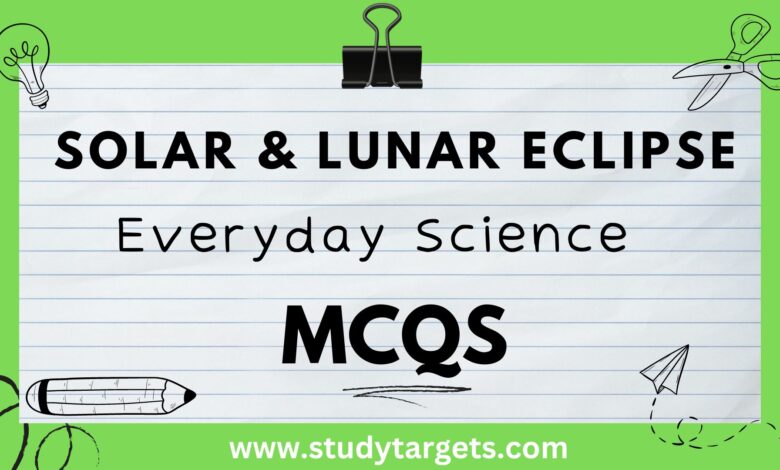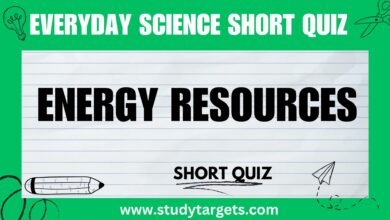MCQs: Solar & Lunar Eclipse: Everyday Science MCQs:

Solar & Lunar Eclipse
1. What is a solar eclipse?
a) When the Moon passes between the Sun and Earth, blocking the Sun’s light
b) When the Earth passes between the Sun and Moon, blocking the Moon’s light
c) When the Earth casts a shadow on the Moon, causing it to darken
d) When the Moon casts a shadow on the Earth, causing darkness
Answer: a) When the Moon passes between the Sun and Earth, blocking the Sun’s light
2. During a total solar eclipse, what part of the Sun is visible?
a) Sun’s corona
b) Sun’s core
c) Sun’s photosphere
d) Sun’s chromosphere
Answer: a) Sun’s corona
3. Why don’t solar eclipses occur every month?
a) The Moon’s orbit is tilted with respect to Earth’s orbit.
b) The Moon’s shadow does not always reach Earth.
c) The Sun’s brightness is constant throughout the year.
d) The Moon’s size changes regularly.
Answer: a) The Moon’s orbit is tilted with respect to Earth’s orbit.
4. What is the darkest part of the Moon’s shadow during a solar eclipse called?
a) Penumbra
b) Corona
c) Umbra
d) Photosphere
Answer: c) Umbra
5. During a lunar eclipse, what causes the Moon to appear reddish in color?
a) Earth’s shadow completely blocks all sunlight from reaching the Moon.
b) Earth’s atmosphere scatters the blue light, allowing the red light to pass through.
c) The Moon’s surface reflects red light from nearby stars.
d) The Sun’s light refracts and creates a red halo around the Moon.
Answer: b) Earth’s atmosphere scatters the blue light, allowing the red light to pass through.
6. Which type of lunar eclipse occurs when the Moon passes only through Earth’s penumbral shadow?
a) Partial lunar eclipse
b) Total lunar eclipse
c) Penumbral lunar eclipse
d) Annular lunar eclipse
Answer: c) Penumbral lunar eclipse
7. How often do total solar eclipses occur at any specific location on Earth?
a) Every year
b) Every two years
c) Every five years
d) It varies from location to location
Answer: d) It varies from location to location
8. What is the name of the phenomenon when a sliver of the Sun is still visible around the edges of the Moon during a total solar eclipse?
a) Totality
b) Umbra
c) Annularity
d) Diamond ring effect
Answer: d) Diamond ring effect
9. What is the term for the alignment of the Sun, Earth, and Moon that occurs during an eclipse?
a) Orbital position
b) Celestial conjunction
c) Syzygy
d) Solar event
Answer: c) Syzygy
10. Which type of solar eclipse occurs when the Moon’s apparent size is smaller than the Sun’s, leaving a bright ring of sunlight visible around the Moon’s edges?
a) Total solar eclipse
b) Partial solar eclipse
c) Annular solar eclipse
d) Hybrid solar eclipse
Answer: c) Annular solar eclipse
11. During a total solar eclipse, when is it safe to look directly at the Sun without eye protection?
a) During totality
b) During the diamond ring effect
c) Never, it is never safe to look directly at the Sun during a solar eclipse
d) During partial phases
Answer: a) During totality
12. What is the approximate duration of a total solar eclipse at any given location on Earth?
a) A few seconds
b) A few minutes
c) One hour
d) Half a day
Answer: b) A few minutes
13. When a solar eclipse occurs, what phase is the Moon in?
a) Full Moon
b) Waxing Crescent
c) Waning Crescent
d) New Moon
Answer: d) New Moon
14. Which type of lunar eclipse occurs when only a part of the Moon passes through Earth’s umbral shadow?
a) Penumbral lunar eclipse
b) Partial lunar eclipse
c) Total lunar eclipse
d) Annular lunar eclipse
Answer: b) Partial lunar eclipse
15. Which type of solar eclipse occurs when the Sun, Moon, and Earth are perfectly aligned, but the apparent size of the Moon is larger than the Sun’s, completely covering the Sun’s disc?
a) Partial solar eclipse
b) Total solar eclipse
c) Annular solar eclipse
d) Hybrid solar eclipse
Answer: b) Total solar eclipse
16. What is the approximate frequency of total solar eclipses visible from any specific location on Earth’s surface?
a) Every month
b) Every six months
c) Every year
d) Every two years
Answer: c) Every year
17. Which type of lunar eclipse occurs when the entire Moon passes through Earth’s umbral shadow?
a) Penumbral lunar eclipse
b) Partial lunar eclipse
c) Total lunar eclipse
d) Annular lunar eclipse
Answer: c) Total lunar eclipse




